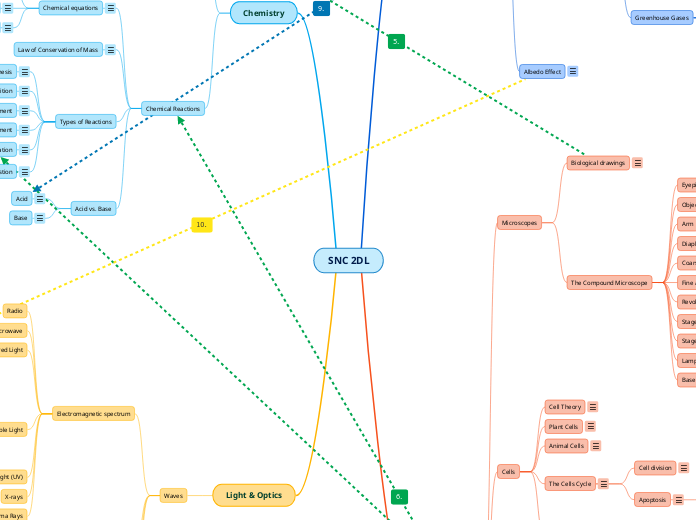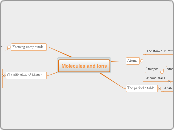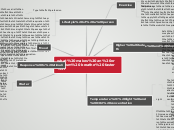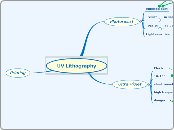SNC 2DL
Light & Optics
Waves
Amplitude
The distance measured from one singular complete wave to the next within a wavelength.
Trough
The absolute lowest
Crest
The uppermost part of a wavelength (its peak)
Electromagnetic spectrum
Gamma Rays
X-rays
Ultraviolet Light (UV)
Visible Light
The Colour Spectrum
The colour spectrum visible to the human eye ranges from red to violet, (ROYGBIV). There are 3 colours true to the human eye, every other colour is our brain's conclusions of what it is seeing. These colours are red, green, and blue. True red and green make up yellow, true red and blue make magenta, and true blue and green make cyan.
Behaviour of Light
Refraction
Transmission
Absorb
Reflect
Infrared Light
Microwave
Radio
Chemistry
Chemical Reactions
Acid vs. Base
Substances that free hydroxide ions when dissolved in water. Many bases have hydroxide ion(s) in their formula (OH-).
- bitter
- conducts electricity
- contains metals
- corrosive
- dissolve in water
Acid
A substance that produces hydrogen ions when dissolved in water. Recognised by their formulas, with at least one (H) at the start.
- sour
- corrosive
- dissolves in water
- conducts electricity
- contains nonmetals
Types of Reactions
Combustion
Fast reactions of a substance with oxygen to produce oxides
- often called burning
- fuel + oxygen --> oxides, water, energy (heat +light)
Burns hydrocarbons: gasoline, natural gas, furnaces, stoves
CxHy = O2 --> CO2 + H2O
Hydrocarbon + oxygen ---> carbon dioxide + water vapour + energy
Incomplete Combustion
Occurs when burning happens, but with not enough oxygen
- 4 products instead of 2
- Carbon monoxide: CO
- Carbon: C (appears as black soot)
- Carbon dioxide: CO2
- Water: H2O
Neutralisation
Acid + Base --> water + ionic compound (SALT)
H__ + ___OH --> H2O + MNm
To recognize a neutralization reaction:
- reactants are an acid + base
- products are water + compound
Double displacement
The cations in two compounds trade places
AC + BD ---> AD + BC
CuBr2 + K2S --> CuS + 2KBr
Single displacement
One element displaces another element in a compound
A + BC --> AC + B
Li + MgCl --> LiCl + Mg
Decomposition
A compound breaks down into 2 elements (or simpler compounds)
AB --> A + B
2NF3 --> N2 + 3F2
Synthesis
2 elements combine to make a compound
A + B --> AB
H + Cl --> HCl
Law of Conservation of Mass
The Law of Conservation of Mass states that in any chemical reaction the mass remains the same before and after the reaction (reactants to products). Matter cannot be created nor destroyed.
Chemical equations
Represents a chemical reaction.
Balanced equation
Includes coefficients in front of symbols so every atom is represented
ex. Mg (s) + 2HCl (aq) --> H2 (g) + MgCl2 (aq)
Word equation
Uses words/names to represent the reaction
ex. Magnesium (s) + hydrochloric acid (aq) --> hydrogen (g) + magnesium chloride (aq)
Skeleton equation
Uses chemical formulas/symbols to represent the reaction
ex. Mg (s) + HCl (aq) --> H2 (g) + MgCl2 (aq)
Atom
Ions
A positively or negatively charged atom due to the loss or gain of electrons.
Cations = positively charged
Anions = negatively charged
- nonmetals form cations
- metals form anions
Molecular compounds
- Made up of nonmetals and nonmetals
- consists of the sharing of electrons because both want electrons
- bond formed is called a covalent bond
- Uses prefixes
- Identify the elements
- Use the prefixes to add the correct subscript (no crossing/uncrossing ex. Sulfur tetrehydride = SH4)
Naming molecular compounds
- Given the chemical formula, use the subscript to decide which prefix to use and add it to the element name
- if the first element only has one, do NOT put "mono"
2.The ending of the second nonmetal changes to "ide"
Ionic compounds
Formed from a cation (+) and an anion (-), usually a metal and nonmetal.
- Transfer of electrons
- all that needs to occur is for the elements to be brought together
- bond form is called an ionic bond
Polyatomic ions/compounds
Recognised by the formula having more than 2 elements or the name ends in "ate" or "ite", or some other name.
- to get the formula from the name: recognise the ion and find the formula for the polyatomic ion on the chart
- to get the name from the formula: uncross charges and verify valences if multivalent.
Finding formulas
From the name:
- Write the chemical symbols of each element with its valence.
- Add ions as needed so positives = negatives
- Write the element symbols with the correct subscript TO THE LOWEST TERMS
If the metal is multivalent
- Write the element symbol and its charge
- Cross the charges to complete the subscripts
- REDUCE TO LOWEST TERMS
Naming ionic compounds
- Name the metal first, including roman numerals if multivalent. (Ca = calcium)
- Name the nonmetal second, change the ending to "ide" (ex. Cl = chloride)
- Combine the ion names and name the compound (calcium chloride)
If the metal is multivalent
- Recognise if the metal is multivalent
- Uncross the subscripts to get the valence charge of each elements
- Use the nonmetal valence to verify the charge
- If it is correct, valence is also correct
- If it is incorrect, you need to multiply both the make the metal correct.
Properties
- At room temperature, most are hard, brittle, solids.
- Arrangement of positive and negatively charged ions forms crystals with defined edges when broken
- Every ion is attracted to another in crystal form, therefore they have high melting points.
- When dissolved in water, the ions move freely and solutions conduct electricity.
Biology
Systems
Organ Systems
Animal Organ Systems
11 systems of the human body
Lymphatic
White blood cells, thymus, spleen, lymph nodes, lymph vessels.
- Protects body from disease
- Circulates fluid called lymph
- Absorbs and transports fat
Immunity
Novel Coronavirus
Belongs to the family coronaviridae. Originates from an animal. Club-shaped proteins give a crown-like appearance (coronal).
COVID-19 + Systems
Some people will develop Acute Respiratory Distress Syndrome with the infection.
Lung cells become inflamed making it harder to breathe. Alveoli become filled with fluid, making gas exchange harder, and therefore exhausting other cells as they are not getting enough oxygen.
The virus enters the cell via the ACE-2 receptor, and this receptor is 100x more occurring in the gastrointestinal tract, making vomiting and diarrhoea common symptoms.
Infection of the cell
SARS-CoV-2 infects the cell via the ACE-2 receptor
When COVID-19 infects the cell, it is more easily spread than the common cold, is a more serious illness, and has a longer incubation period before any syptoms appear during which the virus can still be spread.
Reproductive
Respective to males versus females
Excretory
Skin, kidney, bladder, ureter, urethra
Nervous
Brain, nerves, spinal cord
- controls bodily functions
Endocrine
Glands, pancreas, ovaries, testes
- controls growth and development
- controls controls metabolism
Circulatory
The Circulatory System
Transportation path of the body. Transports oxygen, nutrients, hormones, and removes carbon dioxide and wastes. Also distributes heat to body parts and fights against disease.
Pumps deoxygenated blood to the lungs and oxygenated blood to the body. Heart contracts, blood is pushed out of the heart. Heart relaxes, blood flows back in the heart. Sits in the chest cavity between the lungs, about the sized of your clenched fist.
Blood vessels
The pathway of blood
- Arteries carry pressurised, oxygenated blood away from the heart and out towards the extremities and other tissues of the body, then branching into;
- Capillaries. Microscopic, only one cell can travel through at a time. Nutrients and wastes are exchanged, then to return to the heart via;
- Veins. Unpressurised, deoxygenated blood returns to the heart.
Blood
Approx. 4-6L in your body
55% plasma component: consists of water, proteins, nutrients, wastes. Maintains temperature, fights against disease, transports vitamins.
45% cellular component: red blood cells carry oxygen and then remove carbon dioxide; live 100-120 days. White blood cells fight foreign invaders, guard against infection; live for years. Platelets are proteins that release a blood clotting factor (forms scabs).
Respiratory
Nose, mouth, trachea, lungs, bronchi, bronchioles, alveoli, diaphragm
Digestive
The Digestive System
Purpose of breaking down food into nutrients to then supply cells with necessary nutrients for growth, maintenance, and repair
- Ingestion: taking in nutrients (mouth, teeth, saliva, throat)
- Digestion: breaking down nutrients (mouth, stomach, pancreas, gall bladder)
- Absorption: Taking nutrients into cells (small intestine, large intestine)
- Egestion: elimination of solid wastes (colon, anus)
Muscular
All muscle tissue, tendons, ligaments
Skeletal
Bones, cartilage
- Provides shape and structure to the body
- Produces blood cells
Integumentary
Skin, hair, nails, glands
- Acts as a barrier to the other systems
- Regulates temperature
Plant Organ Systems
Shoot System
All above ground (stem, leaves, flower, and fruit)
Xylem pulls nutrients up from the roots through the stem via xylem.
Transpiration occurs as water evaporates from the leaf and therefore pulls up water molecules.
Root System
All below ground, the root system stores water/nutrients, absorbs, and transports from the ground to the stem.
Organs
Different tissues formed together to carry out a function. Includes lungs, skin, heart, etc.
Flower
Reproductive organ of the plant (stamen, pistil, ovary, petal, sepal)
Leaf
Location of photosynthesis/cellular respiration within the plant. Photosynthesis transforms carbon dioxide and water (absorbed via the root system to the stem) into sugar and oxygen.
Stem
Serves to transport nutrients from the roots of the plant to the rest of the plant, and from the plant back down to the roots once photosynthesis occurs within the leaf. Vascular tissue performs this function, xylem up, phloem down.
Roots
The roots anchor the plant, and stores food for the plant, as well as absorbing nutrient necessary from the ground itself.
Skin
- Largest organ of the human body
- Protects all inner cells
- Insulates
- Excretes wastes (i.e. sweat)
Lungs
- Pair of organs involved in respiration
- Breathes in oxygen and out carbon dioxide
- Sit in the chest cavity
Heart
- Muscular pump that provides and circulates blood throughout the body
- Divided into 4 chambers (right/left atrium, right/left ventricle)
Tissues
Animal
Nervous tissue
Inputs signals, responds, causes reactions.
Muscle tissue
Cardiac muscle tissue
Heart specific muscle tissue, assists the heart in contracting and relaxing to pump blood to the rest of the body (circulatory system).
Smooth muscle tissue
Responsible for involuntary muscle movements, such as peristalsis, digestion within the stomach (i.e. walls), and the passing of nutrients through the intestines.
Skeletal muscle tissue
Responsible for voluntary movement of the body
Connective tissue
Fills space, makes up all other sorts of components to the body including blood, bones, ligaments, tendons, fats, etc.
Epithelial tissue
Protects and lines structures of the organism.
Plant
Vascular tissue
Transports nutrients and other materials throughout the plant. (xylem up and phloem down)
Ground Tissue
Provides structure and support to the organism.
Epidermal tissue
Protective layer on the outside of plant organs.
Meristematic tissue
Tissue made up of unspecialized stem cells with the purpose of growth within the plant.
Cells
Specialized cells
All cells start the same and then differentiate into specialised cells. Differentiation occurs so cells are assigned a specific function.
Stem cells
Unspecialised cells that have the potential to differentiate to become any cell and undergo any function. Scientists are interested in stem cell studies because of the potential to genetically differentiate stem cells to then repair and replace damaged tissue, such as in a cancer case.
The Cells Cycle
Interphase
Mitosis
Cytokineses
Apoptosis
Apoptosis
Apoptosis is the controlled death of a cell. A cell regularly undergoes 50-60 cell divisions before apoptosis occurs. Takes place when the cell can no longer preform its function or is no longer needed.
Cancer cells
A cell in which the genetic instructions (DNA) have been mutated and the cell loses control over it's division. These cells are essentially "immortal" because they do not stop dividing regardless of damage to the cells.
Tumours
A mass growth of cells
Malignant
Dangerous and could result in the death of the organism
Benign
Not dangerous to the organism (not cancerous)
Cell division
Cell division takes place for the purpose of growth of an organism, reparation of damaged cells/tissues, replacement of old cells, and reproduction.
Cell division begins with Interphase. During interphase, the nucleus of a cell is visible. The purpose of interphase during the cell cycle is:
- Growth
- Replication of DNA
- Execution of regular cell activities
Prophase
- Chromatin coils into chromosomes
- Nuclear membrane disappears
- Centrioles migrate to the poles of the cell
- Spindle fibers form
Metaphase
- Chromosomes line up at the equator of the cell
Anaphase
- Chromosomes move away from each other
Telophase
- New nuclear membranes form
- Spindle fibers disappear
- Chromosomes unwind
Cytokinesis
- Cytoplasm is divided in half
- Organelles are also divided in half
- Cell plate forms and divides plant cells
- Cleavage furrow divides animal cells
Animal Cells
The organelles of the animal cell include:
-Cell membrane, separates the outside of the cell from the inside, controls movement of things in and out of the cell
-Nucleus, acts like a container; holds DNA and the nucleolus inside, control centre of the cell
-Chromatin: DNA that stores instructions for the cell's function
-Nucleolus, builds ribosomes
-Cytoplasm, jelly supporting organelles
-Endoplasmic Reticulum, transports materials through the cell
- Ribosomes, manufactures proteins that can be used in and outside of the cell
-Mitochondria, creates energy for the cell (site of cellular respiration)
-Golgi bodies, packages useful materials and sends them outside of the cell
-Lysosome, breaks down food, wastes, and other materials (cells break down if lysosome explodes)
-Vacuole, contains water, food wastes, and other materials that help maintain the shape
Plant Cells
Organelles of the plant cell include:
-Cell wall, specific to the plant cell, provides support and strengthens the cell and it's shape
-Cell membrane, separates the outside of the cell from the inside, controls movement of things in and out of the cell
-Nucleus, acts like a container; holds DNA and the nucleolus inside, control center of the cell
-Chromatin: DNA that stores instructions for the cell's function
-Nucleolus, builds ribosomes
-Cytoplasm, jelly supporting organelles
-Endoplasmic Reticulum, transports materials through the cell
- Ribosomes, manufactures proteins that can be used in and outside of the cell
-Mitochondria, creates energy for the cell (site of cellular respiration)
-Golgi bodies, packages useful materials and sends them outside of the cell
-Lysosome, breaks down food, wastes, and other materials (cells break down if lysosome explodes)
-Central vacuole, contains water, food wastes, and other materials that help maintain the shape
-Chloroplast, makes food for a plant cell (location of photosynthesis within the plant cell)
Cell Theory
The cell theory states;
-All living things are made up of cells
-Cells are the smallest working units of all living things
-All cells come from preexisting cells through cell division
Microscopes
The Compound Microscope
Base
Provides a stable platform for the microscope
Lamp
Supplies the light that passes through the specimen
Stage
Supports the slide for observation
Stage clips
Holds the slide in position on stage
Revolving nose piece
Fine adjustment knob
Sharpens an image
Coarse adjustment knob
Moves the stage up and down to focus on the specimen
Diaphragm
Allows light to pass through to the specimen; focuses light on the specimen
Arm
Holds the tube in place and is used to carry the microscope
Objective lenses
Magnify specimen, three lenses are usually 4x, 10x, 40x
Eyepiece/occular lens
Magnifies the specimen, usually by 10x
Biological drawings
Always use pencil!
Solid lines (no sketching)
Darker and lighter areas are contrasted using stippling
Don't cross label lines, labels to one side
Climate Change
Albedo Effect
Earth's method of controlling Sun's radiation
- Albedo measures how much of the Sun's rays are reflected off of a surface versus absorbed into the Earth
The Greenhouse Effect
Natural way for the Earth to stay warm. Normally, the amount of gases in the atmosphere is enough to moderate climate.
Greenhouse Gases
Water vapour
Water absorbs heat, more water vapours in atmosphere = warmer temperatures, makes more clouds (may have reflective effect)
Nitrous oxides
Naturally produced via the nitrogen cycle
Methane
Naturally occurring in low oxygenated areas ex. swamplands
Carbon Dioxide
Released naturally via the carbon cycle (slow process), released in natural forest fires.
The Anthropogenic Greenhouse Effect
Resulting from the influence of humans on nature;
Earth naturally keeps the greenhouse gasses in balance so that the atmosphere keeps the temperature ideal for the biosphere, human activities increase these levels.
Economic effect
Ex. In light of the climate cause, many governments choose to impose carbon taxes. In addition, prices of hydrocarbons (i.e. gas/petrol) will increase moving into the future, which not every household can afford.
Social effect
In impoverished countries, often 3rd-world countries, water access becomes increasingly limited as Day Zero approaches continuously. Water access is often tasked to the women, decreasing the amount of women who are completely educated within the countries. A lower rate of education has been shown to increase the amount of accidental/unplanned pregnancies as well as the average age a woman gives birth at decreasing. These factors will contribute to increasing populations.
Physical effect
Ex. Due to increased levels of precipitation and warmer temperatures melting snow quicker, flooding and water erosion become more of a common occurrence with more detrimental effects.
Adaptation vs. Mitigation
Mitigation
Adaptation
Sink
Something that takes out said element/compounds from the atmophere ex. carbon sink
Source
Something that contains and releases said element/compounds into the atmosphere ex. carbon source
Earth's Spheres
Hydrosphere
Liquid water, water vapour, and ice
Lithosphere
Rock, mantle, Earth's crust
Atmosphere
Gases surrounding Earth
Biosphere
Living organisms and ecosystems
Weather
Environmental conditions occurring in a particular place and time.
Climate
Average weather conditions in a region over long periods of time. (ex. average precipitation)









